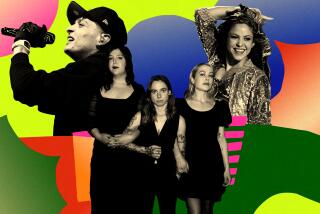The Elusive Cocteau Twins : ‘Blue Bell Knoll’ Rings Through Record Stores--Another Majestically Murky Album
- Share via
Moosa d-r-r-rees a walky way
Shine nyoona colosa fair
Vincenzo the she-she kaff
What?
No, our computerized typesetting system hasn’t sprung a microchip. The lines above represent more or less all that one can make out of a typical song by the world’s most intriguing, entrancing and utterly baffling pop band, the Cocteau Twins.
Be prepared. They’re coming your way. The Twins have been releasing albums on the small 4AD label in Britain since 1982, but their first U.S. major-label (Capitol) release, “Blue Bell Knoll,” just reached the record stores.
There is singing on almost every Twins track, but the “lyrics” are usually indecipherable. No help comes from a lyric sheet--or from the band, which has never cared to explain what it’s up to.
Neither in interviews nor in the recording studio nor at their rare live appearances have the Cocteaus had anything to “say.” “If we had loads of wonderful things to say,” one of them told British journalists, “we’d be writers. We wouldn’t want to make music.”
That should have killed them off with the British press right there. Pop critics demand that bands have “something to say” before giving their stamp of approval. And yet the U.K. scribes have gone gaga over the group. New Music Express’ 1986 rave, “a music of staggering splendor and gossamer beauty,” was a typical response.
That the Cocteau Twins are different from you and I and Bon Jovi is apparent even before you hear them. The LP and EP covers, which never feature photos of the band, are abstract splashes of color (or, in the case of colorfully titled “The Pink Opaque,” black and white). Beautiful glop. Like the music.
This music revolves around bass and guitar (and, to a lesser extent, synthesizers) “treated” by effects that blur their shapes into a dreamy drone. A steadily beating drum machine helps keep things in order. The influences are largely unidentifiable, with snatches of the exotic--Bulgarian? Indonesian?--as prevalent as post-punk and art-rock.
Strangest of all, the vocals: They are female; sometimes there’s just one voice; often there are two--one sassy and low, the other angelic-high, both trill and twist and perform whooping loops with amazing grace. A novice might be tempted to guess that the CTs are two eccentric Parisian sisters who have immigrated to London from the left bank and joined up with British musicians.
Not quite. The Cocteau Twins are actually a trio. Two are from Scotland. Only one (Elizabeth Fraser) is a woman. The other Scot’s her boyfriend, Robin Guthrie. Simon Raymonde, an Englishman who replaced Will Heggie in 1984, completes the group.
Given the Cocteau Twins’ elusiveness, how does this fan express what he finds so magical about a group he’s listened to more than any other--U2, the Cure and the late Joy Division offer the only competition--during the ‘80s?
Only one way even comes close. It’s as pretentious as hell, but here goes: The Cocteau Twins are to pop music what the impressionists were to painting in the late 19th Century.
Impressionism has often been described as a study in (or of) light. “The true subject matter of all these pictures is light alone,” wrote one art historian, “the most impalpable, immaterial phenomenon in all of nature.”
Yet is not sound as “impalpable and immaterial” as light?
What is contained in the Cocteau Twins’ music might actually be better described as meta -impressionism, and its poetic atmosphere is analogous to that of British/American 19th-Century works--like J. M. W. Turner’s “Rain, Steam and Speed” and James Whistler’s “Nocturne in Black and Gold: The Falling Rocket”--which are even more non-representational than most French impressionism.
To gaze into these paintings is to immerse oneself in swirling, mysterious, mesmerizing whirlpools of color. They are deceptively simple. They are magical.
The same thing can be said of the Cocteau Twins’ sonic obscurations.
This analogy with painting also provides the best defense, if one is needed, for the “insignificance” of Fraser’s subjects (when they can be made out).
“Sugar Hiccup” seems to be about the small sound with which one greets people (“sugar hiccup, our Cheerios”) after eating sweetened breakfast cereal too fast. “The Spanglemaker” seems to be about the way a broken window plays with light.
Fraser may be open to derision for writing about such things. And yet in other arts this approach is not at all uncommon or considered unrewarding. Think of all the still lifes--of fruit and “lesser” things--that great painters have rendered.
(Incidentally, Fraser can sing “normal” lyrics--witness her versions of Tim Buckley’s “Song of the Siren” and Roy Harper’s “Another Day” on the first “This Mortal Coil” LP (by various 4AD artists)).
Though they’re triumphs of impressionist minimalism, the swirls of sound on the very best Cocteau Twins albums and EPs--”Head Over Heels,” “The Pink Opaque,” “Akea-Guinea” and above all “Treasure”--do not consist merely of pretty pastels; dark strokes, exotic phrasing and jagged lines keep things ever interesting and challenging.
What of “Blue Bell Knoll”? With slight reservations, it can be recommended.
The reservations: Since 1986, the Cocteau Twins have tended to emphasize softer elements to the detriment of more abrasive ones. Oh, the feathers still get ruffled on the new album --particularly on side one, which contains one of the group’s finest songs, “Athol-Brose.” There simply isn’t, though, the moments of glorious dissonant dynamism found in previous tunes like “Musette and Drums.”
“Athol-Brose?” That’s nothing--listen to these other titles from the new LP: “The Itchy Glowbo Blow” . . . “A Kissed Out Red Floatboat” . . . “Ella Megalast Burls Forever” . . . “Spooning Good Singing Gum.”
Has not Fraser the Titleweaver outdone herself? While the Cocteau Twins have not outdone themselves musically with “Blue Bell Knoll,” they also have not quite yet blissed out--though a few (and maybe many) new fans may.
More to Read
The biggest entertainment stories
Get our big stories about Hollywood, film, television, music, arts, culture and more right in your inbox as soon as they publish.
You may occasionally receive promotional content from the Los Angeles Times.









